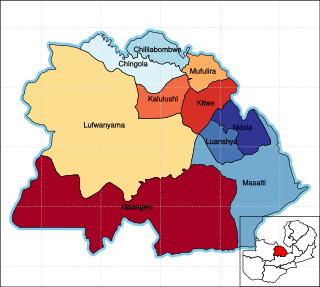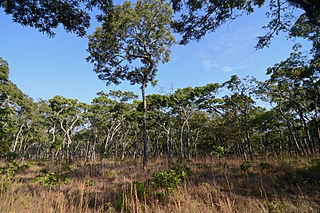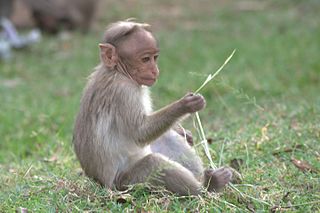
The chimpanzee, also known as simply the chimp, is a species of great ape native to the forest and savannah of tropical Africa. It has four confirmed subspecies and a fifth proposed one. When its close relative the bonobo was more commonly known as the pygmy chimpanzee, this species was often called the common chimpanzee or the robust chimpanzee. The chimpanzee and the bonobo are the only species in the genus Pan. Evidence from fossils and DNA sequencing shows that Pan is a sister taxon to the human lineage and is humans' closest living relative. The chimpanzee is covered in coarse black hair, but has a bare face, fingers, toes, palms of the hands, and soles of the feet. It is larger and more robust than the bonobo, weighing 40–70 kg (88–154 lb) for males and 27–50 kg (60–110 lb) for females and standing 150 cm.

Chingola is a city in Zambia's Copperbelt Province, the country's copper-mining region, with a population of 216,626. It is the home of Nchanga Copper Mine, a deep-shaft high-grade content copper mining operation, which subsequently led to the development of two open pit operations, Chingola Open Pit and then Nchanga Open Pit.

Gombe Stream National Park is a national park in Kigoma District of Kigoma Region in Tanzania, 16 km (10 mi) north of Kigoma, the capital of Kigoma Region. Established in 1968, it is one of the smallest national parks in Tanzania, with only 35 km2 (13.5 sq mi) of protected land along the hills of the eastern shore of Lake Tanganyika. The terrain is distinguished by steep valleys, and the vegetation ranges from grassland to woodland to tropical rainforest. Accessible only by boat, the park is most famous as the location where Jane Goodall pioneered her behavioural research on the common chimpanzee populations. The Kasakela chimpanzee community, featured in several books and documentaries, lives in Gombe National Park.

Copperbelt Province is a province in Zambia which covers the mineral-rich Copperbelt, and farming and bush areas to the south. It was the backbone of the Northern Rhodesian economy during British colonial rule and fuelled the hopes of the immediate post-independence period, but its economic importance was severely damaged by a crash in global copper prices in 1973. The province adjoins the Haut-Katanga province of the Democratic Republic of the Congo, which is similarly mineral-rich.

The chacma baboon, also known as the Cape baboon, is, like all other baboons, from the Old World monkey family. It is one of the largest of all monkeys. Located primarily in southern Africa, the chacma baboon has a wide variety of social behaviours, including a dominance hierarchy, collective foraging, adoption of young by females, and friendship pairings. These behaviors form parts of a complex evolutionary ecology. In general, the species is not threatened, but human population pressure has increased contact between humans and baboons. Hunting, trapping, and accidents kill or remove many baboons from the wild, thereby reducing baboon numbers and disrupting their social structure.

The Monkey World Ape Rescue Centre is a 65-acre (26.3 ha) ape and monkey sanctuary and rescue centre near Wool, Dorset, England.
The Born Free Foundation is an international wildlife charity that campaigns to "Keep Wildlife in the Wild". It protects wild animals in their natural habitat, campaigns against the keeping of wild animals in captivity and rescues wild animals in need. It also promotes compassionate conservation, which takes into account the welfare of individual animals in conservation initiatives. Born Free also creates and provides educational materials and activities that reflect the charity’s values.

James Michael Cronin MBE was the American co-founder in 1987 of Monkey World in Dorset, England, a sanctuary for abused and neglected primates. He was widely acknowledged as an international expert in the rescue and rehabilitation of abused primates, and in the enforcement of international treaties aimed at protecting them from illegal trade and experimentation.
The International Primate Protection League (IPPL) is a not-for-profit animal welfare organization founded in 1973 in Thailand by Shirley McGreal.
Deborah Fouts was the co-director of the Chimpanzee and Human Communication Institute (CHCI). CHCI was the home of Washoe, the first non-human to acquire a human language, and three other chimpanzees who use the signs of American Sign Language to communicate with each other and their human caregivers. She is an Adjunct Assistant Professor of Psychology (Research) at Central Washington University in Ellensburg, Washington. She is married to former co-director, now retired Roger Fouts.

Ngamba Island Chimpanzee Sanctuary, is an island sanctuary in Uganda, dedicated to the care of orphaned eastern chimpanzees, that have been rescued by the Uganda Wildlife Authority. Many of the chimpanzees were rescued from poachers and are unlikely to survive reintroduction to the wild.

Chipangali Wildlife Orphanage is a not-for-profit organisation dedicated to the rescue and care of orphaned, injured, abandoned, abused or confiscated wild animals in southern Africa. It is located in Bulawayo, Zimbabwe.

The Ugandan red colobus or ashy red colobus is an endangered species of red colobus monkey, recognised as a distinct species since 2001. There is disagreement however over taxonomy with many considering the Ugandan red colobus to be a subspecies. The Ugandan red colobus is an Old World monkey which is found in five different locations across Uganda and Tanzania.

The Central Zambezian miombo woodlands ecoregion spans southern central Africa. Miombo woodland is the predominant plant community. It is one of the largest ecoregions on the continent, and home to a great variety of wildlife, including many large mammals.
Carole Cooney Noon was an American anthropologist and primatologist best known for founding Save the Chimps, a Florida non-profit chimpanzee sanctuary that is the largest such sanctuary in the world as of 2009.

Ape Action Africa is a non-profit NGO founded in 1996 dedicated to the conservation of endangered gorillas and chimpanzees, threatened by the bushmeat trade in Central and West Africa. Ape Action Africa manages the rescue and rehabilitation of Great apes across much of Cameroon, with a large sanctuary in the Mefou forest. Some of these Apes include the Western gorilla, Western lowland gorilla, Cross River gorilla, and the Nigeria-Cameroon chimpanzee. With more than 300 primates in its care, Ape Action Africa is now one of the largest conservation projects of its kind in Africa. Many of the animals arrive at the sanctuary as orphans, mainly due to the illegal bushmeat trade, which has grown in recent years as a result of deforestation of the Cameroonian jungle.
The Pan African Sanctuary Alliance (PASA) is an association of wildlife centers in Africa, founded in 2000 in Uganda. The activities of PASA includes rescuing and caring for orphaned apes and monkeys, promoting the conservation of wild primates, educating the public, empowering communities, and working to stop the illegal trade in wildlife.
The Chimpanzee Rehabilitation Project (CRP) is a rehabilitation center associated with the Pan African Sanctuary Alliance (PASA), located at the River Gambia National Park (RGNP), established in 1979. It is the home of 100 chimpanzees living free in four separate groups spread in three islands.

The grass-in-ear behavior, object-in-ear behavior or grass-in-the-ear technique is a fashion statement-like behavior that some chimpanzees do. The unusual behavior has been named by scientists, and it appears to be one of the first times that chimpanzees have created a tradition that has no discernible purpose.














